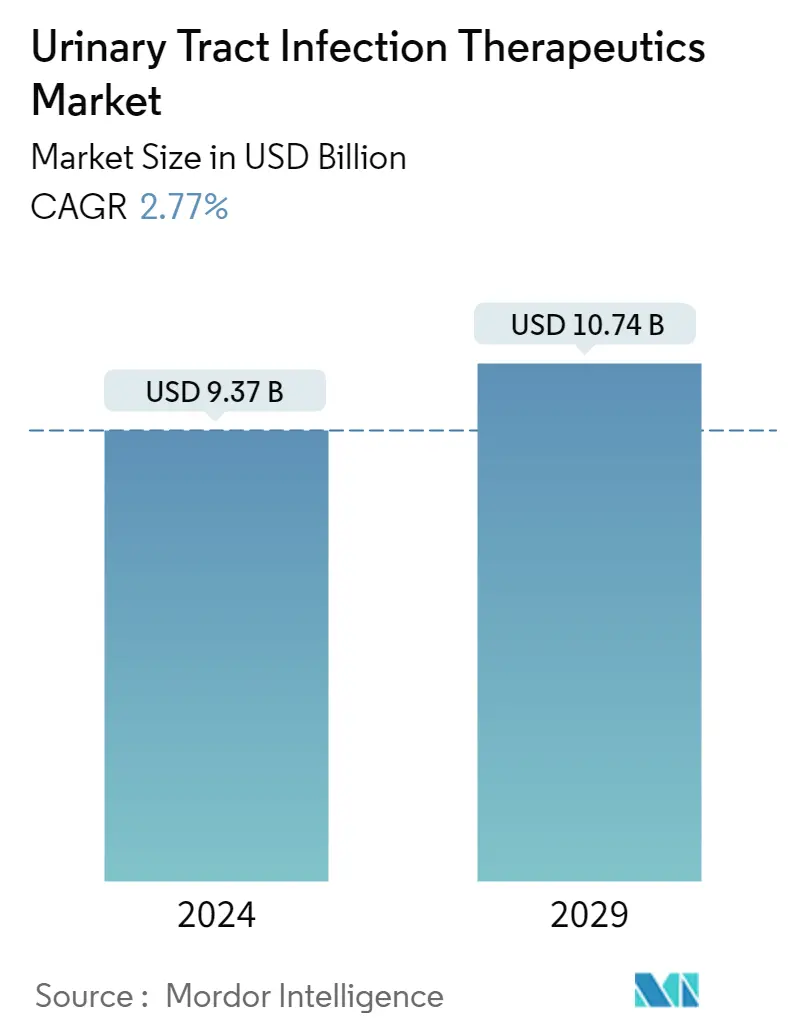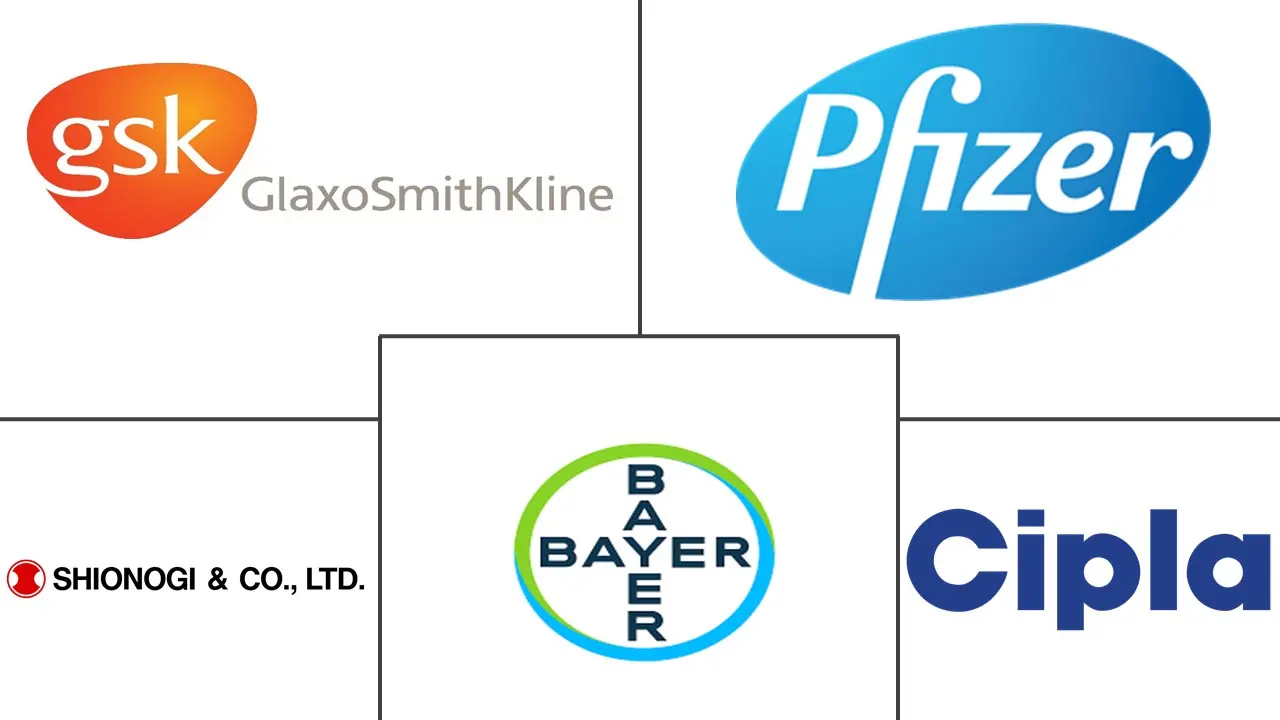Market Size of Urinary Tract Infection Therapeutics Industry

| Study Period | 2019 - 2029 |
| Market Size (2024) | USD 9.37 Billion |
| Market Size (2029) | USD 10.74 Billion |
| CAGR (2024 - 2029) | 2.77 % |
| Fastest Growing Market | Asia-Pacific |
| Largest Market | North America |
Major Players
*Disclaimer: Major Players sorted in no particular order |
Urinary Tract Infection (UTI) Therapeutics Market Analysis
The Urinary Tract Infection Therapeutics Market size is estimated at USD 9.37 billion in 2024, and is expected to reach USD 10.74 billion by 2029, growing at a CAGR of 2.77% during the forecast period (2024-2029).
The unprecedented increase in coronavirus-infected patients had reduced access to other primary care services and resulted in a significant drop in non-COVID-19-related diagnoses, such as urinary tract infection. The weekly rate of UTI diagnosis fell slightly in 2020, which may have slowed the industry's growth in recent months. According to a study published in the ADIAN Journal in December 2020, a significant decrease in urinary tract infection (UTI) diagnoses due to the COVID-19 pandemic raises concern. When people with COVID-19 were infected with SARS-CoV-2, the pandemic changed primary care dramatically. This resulted in fewer patients seeking primary care services and fewer diagnoses, including UTIs. Between March 30 and April 24, 2020, the weekly rate of UTI diagnosis per 100,000 population fell from an average of 30-35 to less than 10 in England. Since April, the rate has risen by 50% of the usual rate. The increase in the rate of UTI diagnosis has positively impacted market growth. Certain factors driving the market growth include the increasing prevalence of diabetes and kidney stones and the launch of combination drugs.
According to the American Academy of Family Physicians (AAFP), in March 2020, by Leonardo Ferreira, kidney stones were a common ailment, with an annual incidence of eight instances per 1,000 persons. As per the same source, around 13% of men and 7% of women may develop a kidney stone during their lifetime, and the total incidence of urinary retention in the US is 4.5 to 6.8 per 1,000 men per year. Moreover, according to the International Federation of Diabetics report in 2021, diabetes affected approximately 463 million persons aged 20 to 79 years worldwide in 2020. This number is anticipated to climb to 643 million by 2030 and 700 million by 2045. In most countries, the proportion of people with Type 2 diabetes is increasing, and diabetes affects 79% of adults in low- and middle-income countries. Urinary tract infections can be especially troublesome for people with diabetes because sugar in the urine serves as a breeding ground for bacteria. Therefore, with the increasing prevalence of diabetes and kidney stones, the number of cases of urinary tract infection (UTI) increases, increasing the demand for drugs, thus, driving the global urinary tract infection therapeutics market.
Additionally, the launch of more efficient combination drugs and the increasing geriatric population is expected to boost the growth of the urinary tract infection therapeutics market. For instance, in February 2020, Allecra, a French pharmaceutical company, announced Exblifep, a combination of enmetazobactam, a novel extended-spectrum beta-lactamase inhibitor, and cefepime, a fourth-generation cephalosporin that met primary endpoints in a clinical trial for complicated UTIs.
However, adverse events associated with the use of medication and the lack of awareness about the prevalence of UTIs in developing and underdeveloped countries are restraining the market's growth.
Urinary Tract Infection (UTI) Therapeutics Industry Segmentation
As per the scope of the report, urinary tract infection (UTI) affects the urinary tract. It is one of the most common bacterial infections, and it is more common in women, as compared to men. The urinary tract infection therapeutics market is segmented by drug (penicillin and combinations, quinolones, cephalosporin, azoles and amphotericin b, nitrofurans, and other drugs), indication (complicated UTI, uncomplicated UTI, and other indications), and geography (North America, Europe, Asia-Pacific, Middle-East and Africa, and South America). The report also covers the estimated market sizes and trends for 17 different countries across major regions globally. The report offers the value (in USD million) for the above segments.
| Drug | |
| Penicillin and Combinations | |
| Quinolones | |
| Cephalosporin | |
| Azoles and Amphotericin B | |
| Nitrofurans | |
| Other Drugs (Aminoglycoside Antibodies, Sulphonamides, Tetracycline, etc.) |
| Indication | |
| Complicated UTI | |
| Uncomplicated UTI | |
| Other Indications (Recurring Complicated UTI, Neurogenic Bladder Infection, etc.) |
| Geography | ||||||||
| ||||||||
| ||||||||
| ||||||||
| ||||||||
|
Urinary Tract Infection Therapeutics Market Size Summary
The urinary tract infection (UTI) therapeutics market is poised for steady growth over the forecast period, driven by several key factors. The market is experiencing a resurgence in demand due to the increasing prevalence of conditions such as diabetes and kidney stones, which are known to exacerbate UTI occurrences. The introduction of combination drugs and the growing geriatric population are further propelling market expansion. Despite the initial slowdown in UTI diagnoses during the COVID-19 pandemic, the subsequent rise in diagnosis rates has positively impacted market growth. The market is characterized by a competitive landscape with major players like AstraZeneca, Bayer AG, and Pfizer, who are actively involved in product launches and regulatory approvals to enhance their market presence.
However, the market faces challenges such as adverse medication events and limited awareness in developing regions, which could hinder growth. The prevalence of complicated UTIs is expected to rise due to increasing bacterial resistance and recurrence rates. Nonetheless, innovations in diagnostic methodologies and the development of novel antibiotics are anticipated to bolster market growth. Regulatory approvals from entities like the US Food and Drug Administration are also expected to contribute to market dynamics. Overall, the urinary tract infection therapeutics market is set to grow steadily, supported by a combination of rising prevalence of UTIs, strategic product developments, and regulatory advancements.
Urinary Tract Infection Therapeutics Market Size - Table of Contents
-
1. MARKET DYNAMICS
-
1.1 Market Overview
-
1.2 Market Drivers
-
1.2.1 Increasing Prevalence of Diabetes and Kidney Stones
-
1.2.2 Launch of Combination Drugs
-
-
1.3 Market Restraints
-
1.3.1 Adverse Effects Associated with the Use of Medication
-
1.3.2 Lack of Awareness in Developing and Underdeveloped Countries
-
-
1.4 Porter's Five Forces Analysis
-
1.4.1 Threat of New Entrants
-
1.4.2 Bargaining Power of Buyers/Consumers
-
1.4.3 Bargaining Power of Suppliers
-
1.4.4 Threat of Substitute Products
-
1.4.5 Intensity of Competitive Rivalry
-
-
-
2. MARKET SEGMENTATION (Market Size by Value - USD million)
-
2.1 Drug
-
2.1.1 Penicillin and Combinations
-
2.1.2 Quinolones
-
2.1.3 Cephalosporin
-
2.1.4 Azoles and Amphotericin B
-
2.1.5 Nitrofurans
-
2.1.6 Other Drugs (Aminoglycoside Antibodies, Sulphonamides, Tetracycline, etc.)
-
-
2.2 Indication
-
2.2.1 Complicated UTI
-
2.2.2 Uncomplicated UTI
-
2.2.3 Other Indications (Recurring Complicated UTI, Neurogenic Bladder Infection, etc.)
-
-
2.3 Geography
-
2.3.1 North America
-
2.3.1.1 US
-
2.3.1.2 Canada
-
2.3.1.3 Mexico
-
-
2.3.2 Europe
-
2.3.2.1 Germany
-
2.3.2.2 UK
-
2.3.2.3 France
-
2.3.2.4 Italy
-
2.3.2.5 Spain
-
2.3.2.6 Rest of Europe
-
-
2.3.3 Asia-Pacific
-
2.3.3.1 China
-
2.3.3.2 Japan
-
2.3.3.3 India
-
2.3.3.4 Australia
-
2.3.3.5 South Korea
-
2.3.3.6 Rest of Asia-Pacific
-
-
2.3.4 Middle-East and Africa
-
2.3.4.1 GCC
-
2.3.4.2 South Africa
-
2.3.4.3 Rest of Middle-East and Africa
-
-
2.3.5 South America
-
2.3.5.1 Brazil
-
2.3.5.2 Argentina
-
2.3.5.3 Rest of South America
-
-
-
Urinary Tract Infection Therapeutics Market Size FAQs
How big is the Urinary Tract Infection Therapeutics Market?
The Urinary Tract Infection Therapeutics Market size is expected to reach USD 9.37 billion in 2024 and grow at a CAGR of 2.77% to reach USD 10.74 billion by 2029.
What is the current Urinary Tract Infection Therapeutics Market size?
In 2024, the Urinary Tract Infection Therapeutics Market size is expected to reach USD 9.37 billion.

